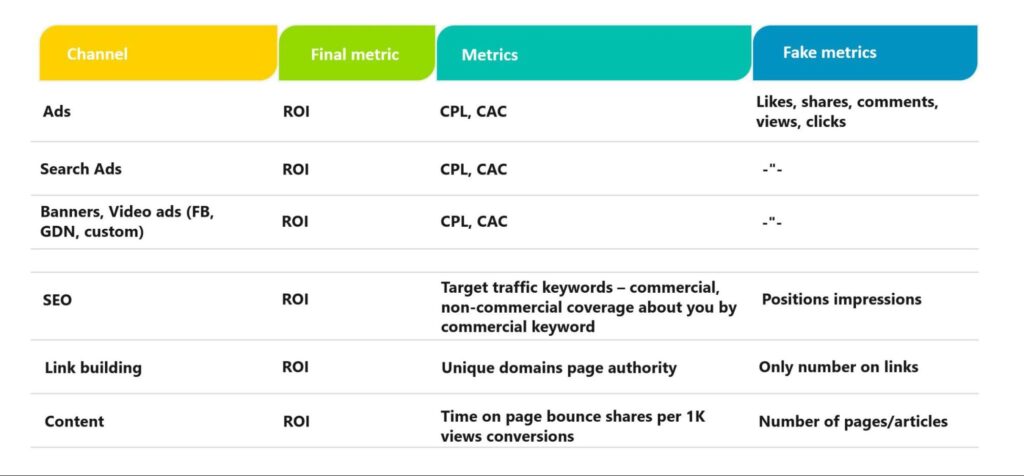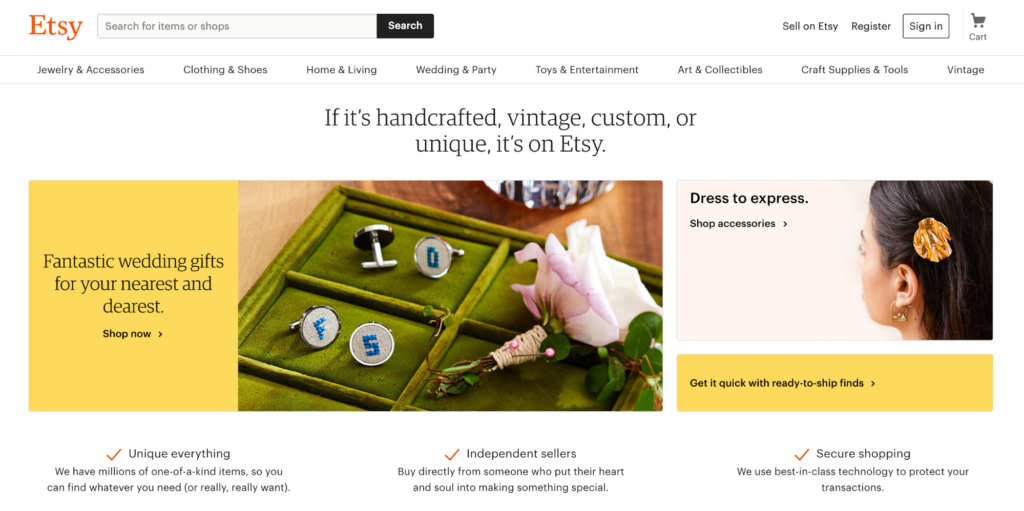
Where do you draw the line when investing in marketing?
Any business is created to generate profit. You invest money into your team and into developing and maintaining a product or service, and you expect it all to pay off. And every single unit, every single action, should work on making that happen.The same goes for marketing, as it’s also a kind of investment. Learning your target audience and competition, attracting customers, nurturing your client base, gathering feedback about the product — all these things require time and money, and all of them need to bring you ROI after.But how do you know which marketing activities bring you profit and which are just another money leak? Marketing is not something tangible like equipment that you can evaluate, buy, and then sell if necessary. So, it needs a specific approach to become a projected and measurable source for your company’s growth.
Key Concepts & Definitions
Regardless of whether you hire a marketing agency or an in-house professional to cover your needs, you have to understand the basic marketing terms and concepts, which will help you hold control over the results and know for what exactly you are paying.Here are the main terms every business owner should know. Some of them are quite common, while others are more specific and connected with the modern understanding of marketing:- Target audience. This is a common term that means people who may potentially become customers of your business. But it’s important to define your audience and its segments not demographically (sex, age, etc.), or at least not only demographically, but based on the GPJ (Gains, Pains, Jobs) model. This means that you should think of who they are and what they need, thus why they would wish to buy your product.
- Advertising channel. This is any platform you can use as a means of communication with your target audiences, such as social networks (Facebook, Instagram, Twitter), blogs, and search engines, as well as more traditional channels like TV or radio advertising.
- Message. A message is what you communicate to your audience. More precisely, it is what you mean and what they perceive. For example, “We care about your health” or “We support sports” — you don’t necessarily need to speak these exact words, but your ads may deliver this as a core message.
- Marketing funnel. It is all the ways you use and all the steps you take to convert your target audience into customers. Here’s what a typical funnel looks like:

- Lead. It’s a potential customer who has entered your marketing funnel and taken the first target action (for example, filled in a form) but hasn’t paid yet.
- Conversion rate. This is a percentage of people who moved to the next step of your marketing funnel out of the whole number of interactions. For example, if 1000 people entered your landing page and 200 people applied, the conversion rate is 200 / 1000 = 20%.
Risk Management in Marketing
There’s a quite common situation when a potential marketing contractor comes to a company with a proposition that sounds like “Let’s invest a bunch of money into ads and then see what happens.” That would be, well, not the best solution ever, especially when you have absolutely no idea whether it will pay off or notIf you inherit the investor’s point of view, you should never pay a penny without preliminary investigations. Of course, there are situations when you cannot be totally sure, especially in marketing, but you should at least understand the risks, expenses, and approximately expected results.Here’s a simple analogy: imagine you are the CFO of a pharmaceuticals company and the Operations Officer shows up with a proposition to install some sort of $2 million worth of machinery that can (in theory) produce more drugs. They say you absolutely need it because “your competitors also have it.” Maybe it could “increase production by about 20% in about four months,” but they can’t be sure yet.
You wouldn’t accept the offer. You wouldn’t spend even two thousand if you didn’t know if an investment like that would pay off.The same applies to marketing. You shouldn’t accept a marketing campaign offer with too many unknown variables or uncertain terms. But how do you know if the offer is good? Here’s what you should do to make an educated decision.
Do a feasibility study
Will the campaign be profitable within the estimated cost? Will you get a return on investment? Experienced marketing professionals always start with a feasibility study, which is used to check the channel’s actual profitability.To make things more convenient, you can transfer financial terminology onto marketing:- Feasibility study = Marketing channel test
- Investment proposal = Marketing budget draft
- Letter of intent = Preliminary approval of the marketing budget
- Due diligence, Risk mitigation = Discussions between CFO & CMO
Identify and evaluate risks
What can possibly go wrong with a marketing campaign or with testing a channel? The obvious thing is the financial side, which should be clarified down to the details. There could also be legal, environmental, or operational issues, but the most risk you take is with the channel itself. It might not give you the outcomes you have estimated (e.g., sufficient conversion).If a contractor offers you an attractive yet sketchy combination that lies on the margins of the rules, beware. The more what-ifs you ask your contractor, the easier it is to evaluate whether the campaign is worth it.Differentiate between low- and high-risk marketing channels
Anything that might not pay off is a risk. The channels you have already tested are in the safe zone. They are low-risk because you already know the traffic share on that channel and how much it costs to acquire a client. New channels are always high-risk.It’s a good idea to combine both tried and new marketing channels in your strategy. Test high-risk channels before your competitors discover them, but only when you keep both feet on the ground with low-risk ones.How much is enough?
Let’s get back to a more general question: how much is worth spending for marketing? The short answer is as much as is beneficial from the investment perspective.However, many variables affect any marketing activity, and it is hard to predict the outcomes, especially when you are just launching your first promotion campaign.And here we move to the next question — how do you evaluate the efforts? This will help you hold control over the main activities and budgets.Key Marketing Metrics
Every step of your marketing campaigns should be measured and analyzed. Moreso, you should do this systematically to watch changes in performance over time. So let’s talk about the key factors that define the campaign’s efficiency.Here are the main metrics that every business owner should know and understand:- CR (conversion rate, or % conv) — It’s the percentage of people who have completed a target action. If you look back at the marketing funnel, we had 100 people out of 1000 hitting the landing. In this case, the conversion rate is 10%.
- CPL (cost per lead) — It’s pretty straightforward; the more leads you get within the same campaign, the cheaper each of them is. So here, you divide the total amount spent on advertising by the number of leads attributed to a campaign. So, if you spend $1000 on Facebook advertising and get 50 leads, then your CPL will be $20.
- CAC (customer acquisition value) — The cost of acquiring new customers is calculated based on the total amount of marketing and advertising expenses within a certain period. Back to our Facebook Ad campaign, if you spend $1000 and it gives you 10 customers, then the value for each customer is $100.
- LTV (lifetime value) — This one defines the average total income you get from your clients within the period of your cooperation. Here you take average monthly spending on your product or service and multiply it by the average number of months that they are your client. The goal is to make LTV bigger than CAC.
How to Evaluate Marketing Assets
So, you have assessed the risks, performed a feasibility study, all metrics are at hand, and you’re ready to roll with testing channels you deemed worthy of the risks. There’s one more step you need to take before you go on to the practical part, and it’s evaluating your marketing assets. Make the most out of what you already have.Here are some examples of marketing assets:- A website. Any landing pages, the corporate website, and other sites you have built for your business could be a $500 or a $100,000 asset (considering prices for creation) that may continuously bring you clients.
- Subscribers. Communication through email and messengers (such as Telegram, Facebook Messenger, and WhatsApp) with the target audience, as well as application forms, may generate subscribers for you. The subscribers are much easier and cheaper to convert into customers than cold traffic.
- Content (graphic, video, audio, and text). The quality of content you post on the website or social media directly affects how potential customers react to your messages (offers). And yes, the content may be reused in many different ways, so it’s always useful to keep a tab on it.
- Creative content. It’s anything that can attract attention to your brand and convert. For example, you may have banners for social media, paid ad creatives, or any other type of advertising and promoting materials. All of them may be used or at least analyzed.

- Marketing funnels. You have probably already tried some funnels that worked better or worse than others. Anyway, you’d better save all the documents with metrics and results. At least your new marketer can analyze what’s been wrong, or maybe they could use old ideas to bring you more customers.
- SEO (Search Engine Optimization). Your positions in search engines are also an asset that should be used and multiplied. Although SEO is considered a mammoth of internet marketing, it’s still one of the strongest players on the scene.

Another essential to consider is the quality of your assets. Sometimes, it’s better to start something from scratch if it’s done badly or becomes outdated. Otherwise, it may spoil the effect of all the other marketing efforts. For example, if a website is too old, it may have an adverse effect on visitors’ trust, or if the content is of poor quality, it may increase CAC dramatically.The next question is what exactly you should do, how to choose marketing channels, and how to evaluate the results.
How to Analyze Marketing Channels
Prioritization of opportunities
There are a great number of marketing channels, and they’re not so easy to choose from. Search engines, social networks, mass media… Some channels are more popular, while others your competitors have yet to discover. How do you prioritize the possible opportunities?Marketers think this way:- How many people will see your message?
- How many of them are your target audience?
- How much will it cost you?
- Cost for an advertising campaign: $500
- Total spending on advertising in one year: $1000
- The number of leads acquired: 50
- The number of customers acquired: 100
Measuring the results
After you launch a promotion campaign, you still apply the investment approach. You ask yourself: how much have you spent and earned from each channel? If the balance is positive, then it is a valuable channel.The main metrics here are ROI, CPL, and CAC. You need not only measure them separately for each channel but also compare them with each other. If one channel is more profitable than another, maybe you should redistribute your budget to gain more profits.What you should not do is deeply consider the soap metrics, such as coverage, shares, likes, and comments. It’s something that can complete the whole picture, but it’s totally wrong when a marketer brings you these metrics as the main ones. You should only take account of those things that help you understand money and profits.
What we are looking for is, again, higher ROI (return on investment) and lower CPL (cost per lead) and CAC (customer acquisition cost). What is important here is that CPL and CAC don’t always correlate.More precisely, marketing is mainly about CPL, as its primary goal is to bring more leads to your marketing funnels. Converting them into customers is more about the sales process. So it’s better to analyze these metrics separately. But CAC is also important to evaluate the quality of leads. If they don’t become customers, they are low-quality.
When should you make the evaluations?
The first time should be after the test launch when you consider whether this particular channel is worth using. For different channels, there will be different periods:- Banner ads — A week is enough to give results, and another week will show the actual ROI of this channel.
- CPC ads — In two weeks you will see the first significant results, and after another two weeks you can evaluate the actual ROI.
- SEO requires a lot more time, about three to four months to see the first results and another four to eight to evaluate the actual ROI.
How to Hire Marketing Professionals
Now, we’re onto the fun part. How do you know if you’re hiring good marketing people? Even the test launch will cost you money, and you obviously don’t want to just give it away.The best practice is, of course, testing. If your budget affords it, it’s always better to test multiple agencies simultaneously and compare the results. You will see which contractor outperforms the rest, and that can be a deciding factor. However, there’s no sense in practicing this with SEO. It takes the longest to show results, and moreover, two specialists working at a time might mess up your promotion.Except for testing, there are certain criteria that will help you define whether you can trust a contractor or not.The first meeting
Red flag: “Here’s our [standard] business proposal. We’ll start working after the first paycheck.”Most likely, these guys are just interested in your money, as without getting to know your target audience, defining your marketing assets, or even learning what you do, they can’t actually make a valid proposal. And, quite frankly, they probably won’t.Good practice: “We need to know more facts about your business so we can analyze it and make a proposal.”If a candidate asks you questions about your business and makes an effort to understand how you work, it’s a job well done. Another good indicator is when they point out your flaws (e.g., a link that’s not working or if your sales team doesn’t have scripts for working with leads), thus bringing you value in advance.Proposal
Red flag: You get a generic proposal with standard approaches and pricing schemes. It looks like a template they send to everyone.Good practice: A custom-made business proposal that takes into account the unique features of your business and offers solutionsYou can see if a person is motivated to work by how they are engrossed in the project. Unmotivated contractors are more interested in their paychecks, rather than your success.Competition analysis
Red flag: There is no competition analysis unless you pay in advance. Once again, they are not interested in your success.Good practice: “We’ve studied your competitors’ strengths and weaknesses, and here we have a few ideas on how to outrun them.”Say none of the companies in your segment offer a money-back guarantee, or most of them have weak content. If your marketers investigate such things and offer personalized tactics, it means they are trying to bring you more than the standard procedures that may be used by all of your competitors.Test task
Red flag: They don’t want to complete any tests unless you pay in advance, or they send you a short generic document just to get you off their backs.Good practice: They do even more than was asked in the document and provide you with practical advice or other value.A good agency will go the extra mile to win the client’s loyalty and show how they can bring you profits.Setting up marketing campaigns
Red flag: The campaigns are set up on the agency’s accounts. You might lose all the configurations in case you decide to break the contract.Good practice: The campaigns are set up on your accounts. For example, Facebook has an Ads Manager they should be using with your access credentials, and the same goes for Google and other ads.So, as you see, among many aspects the financial side of choosing a marketing specialist is not the main one. But yes, budgeting is important, so let’s speak about the money.The cheaper, the better?
At first sight, it seems clear: why should you pay more if there is a candidate who agrees to do the same job for less money? But that’s only at first sight. Quite often, a $1500 contractor may cost a company more than the one who bills $5000.How is that possible?It’s quite easy if you know the process. The total cost usually consists of two parts: the advertising budget and the marketer’s earnings.1) Advertising budget. A smaller budget does not necessarily mean cheaper leads. It may also be:- fewer channels, which means fewer possibilities to find the optimal opportunities; or
- less money for testing each separate channel, which will lead to inaccurate results and false forecasts.
In-House Marketers vs. Contractors
Some companies stand for in-house teams, others prefer to outsource whenever possible, and both sides have their reasons. We will not go deep into all the pros and cons but instead give you the main reference points.The first thing that matters is the type of your company and the type of website for marketing.Corporation- Brand websites: for communicating a company’s values and ideas, and showing news and updates
- Conversion websites: for giving information about a company, but also for involving a target action, like becoming a club member or starting a partnership

Personal brand
- Brand websites: purely for sharing purposes, news, and status updates about star professionals, coaches, or trainers
- Conversion websites: used by experts, coaches, trainers, and mentors for teaching purposes and selling their educational programs or services

Marketplaces
- Brand websites: Sometimes marketplaces create brand sites to attract partners and investors.
- Conversion websites: a platform itself whose main goal is to maximize sales

Brand platforms (banks, TV, car salons)
- Brand websites: info about the company, content, projects, and other things, depending on the project
- Conversion websites: Sometimes they are used as additional tools to attract attention to a specific event or service (e.g., exhibition, charity meeting, or TV show).

Conversion websites need an in-house copywriter to write about your company and preferably a marketer to manage the project. If you decide to hire an in-house marketer, it doesn’t have to be a star specialist, but it has to be an employee motivated to work with your business. Other tasks can be delegated to an agency.Brand websites usually don’t need in-house marketers or SEO specialists. A good digital agency can set up internal links and SEO (within six to eight months), but what you do need is an in-house copywriter to work on your blog. But when it comes to creative sites like brand platforms, it’s better to work in-house.

